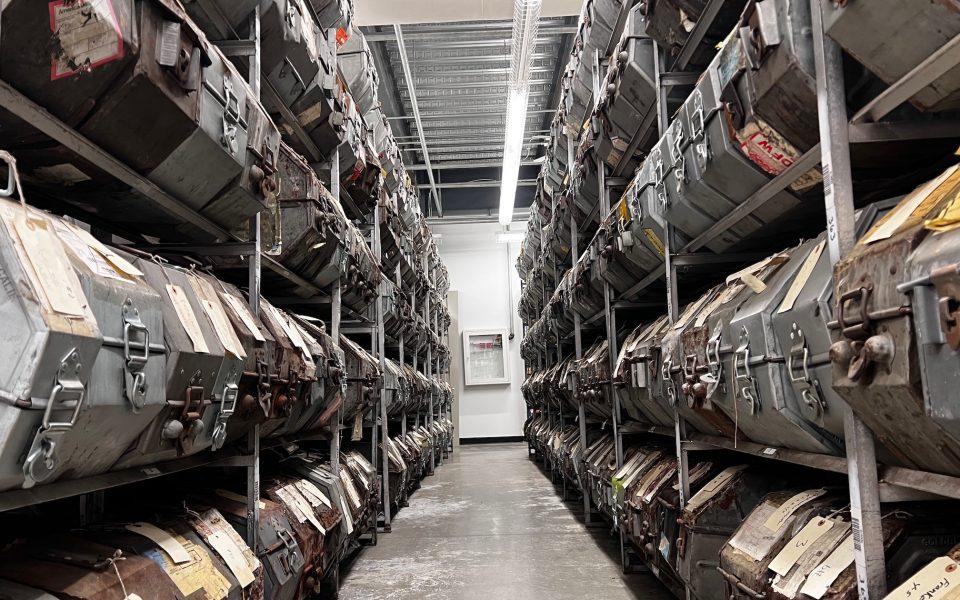Featured photo: UNCSA’s film archive is one of the Top 10 in the world. (photo by James Douglas)
Editor’s note: This story won Second Place in Arts & Entertainment Reporting in the 2022 NC Press Association Awards.
Editor’s note: This story focuses on a part of the University of North Carolina School of the Arts. While we believe that this is an important cultural story, we acknowledge the ongoing controversy that the school has been involved in regarding multiple sexual assault allegations by students against staff and educators dating back decades. For more reporting on that issue, we recommend reading reporting by Michael Hewlett at the Winston-Salem Journal.
Row upon row of the latched metal canisters sit quietly in the climate-controlled room. As in most museums containing precious cargo, the weather doesn’t change, maintaining a balmy 65 degrees year-round. The shelves line the rooms end to end, floor to ceiling, five tiers of these mysterious containers taking up all the available space. The octagon shaped parcels are uniform, tagged, stamped, but each bears the individual marks of wear and travel upon it. Their cargo? Dreams. Magic. Mylar.
They may contain something from your childhood. One might be about an enormous shark attacking the inhabitants of an island that looks suspiciously like Martha’s Vineyard. Another could be about a man’s journey into a “heart of darkness” as he goes upriver to confront Jor-El.
The thing is, we can’t talk about it.
The Moving Picture Archive at the University of North Carolina School of the Arts is mostly nestled in a stout brick building on the Winston-Salem campus. It’s the fifth-largest film archive in the country, the largest being the Library of Congress. The extensive archives include a collection of 16,500 original feature film prints on 70mm, 35mm and 16mm; 240 live-action and animated short films, documentaries and newsreels on 35mm and 16mm; 4,600 previews of coming attractions on 35mm; and 9,300 videocassette, laserdisc and DVD titles, according to the website.
And that’s all that’s described online. No lists are publicly available. And that’s on purpose.
“Private collectors will not tell you what they own, period,” says Matt Jones, the associate curator of the Moving Picture Archive and technical director of the annual RiverRun Film Festival, also based in Winston-Salem. “Every private collector I’ve ever known is massively paranoid; paranoid that someone’s going to take their print, paranoid that someone’s going to pressure them to do something with it, they’d rather just not talk about it.”
Part of the reason for this is copyright complications.
“Copyright for screen, for one time, is $400 to $500,” Jones says.
The school would have to pay that amount to show the average film in their archive to the public. The litigious nature of copyright law and ownership in the 21st Century is a primary barrier to doing it.

In the past, prints were returned to the studio and incinerated after multiple runs when released. Why?
“Because the general thing in Hollywood until very recently is that it would be better for no copy to exist at all, then for the chance to exist that someone might run it and [Hollywood doesn’t] get their cut,” Jones says.
Still, he has ideas that could work if the funds were available.
“If we could show movies to the public once a week, every other week, once a month in the main theatre [on campus], if we could build it up to become regular, it wouldn’t be a cash bonanza, but we could break even,” he says.
And it’s a shame because UNCSA’s collection is massive.
Tags, many of them recognizable to the average moviegoer, adorn each canister which contains holy relics, not unlike one that gets stored at the end of a movie about a certain archeologist.
Silent films and old technicolor prints share space with rare versions of modern-day blockbusters and out-of-print VHS tapes. One might be about a kid who stole a DeLorean and gets lost in time.
“[T]here’s a bit of a scavenger/hoarder/get-it-where-you-can-get-it kind of feeling to being an archivist,” Jones says.
The original assemblage of films came from a private collector in the early days of the school. Combined with a large, fortuitous acquisition from the shuttering of the National Film Service (a storage firm for films) in the late ’90s, the archive quickly became one of the largest in the country. Most films in the archive today are from those sources, donations and a “deposit” system that offers storage in the archive.
“Prints are starting to become more delicate,” Jones says. “The skill sets of handling film are becoming more rarefied, so increasingly archives are assigned to just sit on their collections. There’s a number of things in here that the only way you’re going to get it is if we can get a digital transfer made. These, if you keep them the proper temperature and humidity and everything will last 100 years.”
The purpose of the space is to preserve and to an extent, educate the thousands of film-school students that have attended UNCSA. Some students learn the different aspects of film projection — how to reel, splice and preserve film, a skill which is quickly becoming lost due to digital advances. The school has five big screens made specifically for the purposes of screening the original reels. The theaters are used as classrooms, where film methods are dissected and parsed out by the instructors. They also show student films there. Sometimes though, they just show movies. Because that’s what it’s about: the love of film and storytelling, all preserved in one place, even if no one knows about it.
“I know that I will retire from one of the premier archives in the world,” Jones says. “But I know it will take me until I retire to make it one of the premier archives of the world.”
Join the First Amendment Society, a membership that goes directly to funding TCB‘s newsroom.
We believe that reporting can save the world.
The TCB First Amendment Society recognizes the vital role of a free, unfettered press with a bundling of local experiences designed to build community, and unique engagements with our newsroom that will help you understand, and shape, local journalism’s critical role in uplifting the people in our cities.
All revenue goes directly into the newsroom as reporters’ salaries and freelance commissions.


Leave a Reply